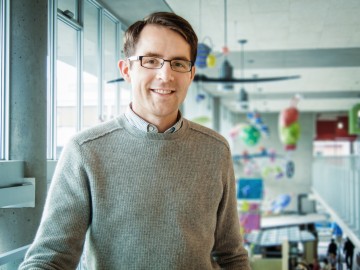Medical residents play two roles — they are physicians, caring for patients, and they are trainees, soaking up the vast amount of knowledge necessary to become expert practitioners in their chosen specialties. But they are often researchers, too. It may be optional, but for many, it’s the natural outgrowth of the process of learning and treating, because it’s another type of questioning. Here is a glimpse of some of the research undertaken by UBC’s current crop of residents:
A novel approach to childhood obesity
Childhood obesity is not only on the rise — it’s also very difficult to treat. Overweight children often remain so into adulthood, and weight management programs have only a modest effect.
Brenden Hursh, a pediatric endocrinology resident at BC Children’s Hospital, is approaching the problem from a different perspective: If their weight can’t be lowered, can the negative consequences of obesity, including Type 2 diabetes, high blood pressure and heart disease, be minimized?

Brenden Hursh
Dr. Hursh, under the supervision of Clinical Professor Jean-Pierre Chanoine, is conducting a collaborative study of 30 children between 12 and 18 years-old – half of them with obesity, half of them of normal weight – to examine the interplay between their inflammatory response and their autonomic nervous system (ANS), which controls involuntary functions such as heart rate, digestion and breathing.
Obesity has been linked to higher levels of inflammation. So the study will describe the children’s levels of inflammation, as well as the in vitro reactions of the children’s blood cells in response to inflammatory stimulants.
The study also will test the sympathetic and parasym- pathetic component of the ANS, with a focus on the anti-inflammatory role of the parasympathetic system. Dr. Hursh and his colleagues will examine the variability of the childrens’ heart rates at rest, and also when performing a grip-strength test and a mental test (tracing a star by looking in a mirror). The children’s caloric consumption during rest also will be measured.
“If we can show there is a relationship between ANS dysfunction and inflammation in childhood obesity, then hopefully in the future we can explore therapies that specifically target the autonomic system, and ward off the obesity-related conditions that arise as they head toward adulthood,” says Dr. Hursh, who earned his M.D. at the Icahn School of Medicine at Mount Sinai in New York and did his pediatric residency at the University of Michigan.
Filling in the blanks of gender dysphoria
Gender dysphoria, a feeling that there is a mismatch between one’s biological sex and gender identity, has emerged in recent years as a genuine medical condition that deserves treatment. But the diagnosis is so new, there is little research to guide clinicians — and almost all of it is from Amsterdam.

Karine Khatchadourian
Karine Khatchadourian helped to fill in some of the blanks, with Canadian cases.
A pediatric endocrinology resident at BC Children’s Hospital, she conducted a retrospective review of 84 patients, 12 to 24 years old, who were seen by the Endocrine Clinic between 1998 and 2011. The study, she says, gives clinicians throughout Canada and the U.S. more culturally-relevant guidance for treating gender dysphoria.
Dr. Khatchadourian, under the supervision of Clinical Professor Daniel Metzger, examined a variety of issues, including: how many came to be seen by specialists, and at what age; the prevalence of mood and anxiety disorders; how many opted to take puberty-blocking medication, and later, cross- hormone treatment to switch their genders.
One of her more intriguing findings, presented at the Endocrine Society’s annual meeting in 2012, was that only one patient out of the 27 who went on puberty blockers didn’t follow through with the transition to another gender. Dr. Khatchadourian sees this as validation of using puberty- blockers as way of smoothing the transition.
Dr. Khatchadourian, who earned her M.D. and did her pediatric residency at the University of Montreal, found that the patients had a much higher percentage of mood and anxiety disorders than the general adolescent population. On a more encouraging note, she also found that many of the male-to-female patients chose to bank their sperm before proceeding with the transition.
“That shows you can have meaningful discussions about fertility with 16-year-olds,” Dr. Khatchadourian says.